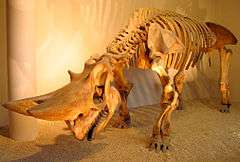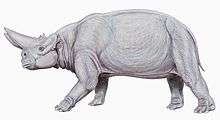Arsinoitherium
| Arsinoitherium | |
|---|---|
 | |
| Arsinoitherium zitteli | |
| Scientific classification | |
| Kingdom: | Animalia |
| Phylum: | Chordata |
| Class: | Mammalia |
| Order: | †Embrithopoda |
| Family: | †Arsinoitheriidae |
| Genus: | †Arsinoitherium Beadnell, 1902 |
| Type species | |
| Arsinoitherium zitteli Beadnell, 1902 | |
| Species | |
| |
Arsinoitherium is an extinct genus of paenungulate mammals belonging to the extinct order Embrithopoda. It is related to elephants, sirenians, hyraxes and the extinct desmostylians. Arsinoitheres were superficially rhinoceros-like herbivores that lived during the late Eocene and the early Oligocene of northern Africa from 36 to 30 million years ago, in areas of tropical rainforest and at the margin of mangrove swamps. A species described in 2004, A. giganteum, lived in Ethiopia about 27 million years ago.
Etymology
The generic name Arsinoitherium comes from Pharaoh Arsinoe I, after whom the Faiyum Oasis, the region in which the fossils were found, was called during Ptolemaic Kingdom, and the Ancient Greek: θηρίον theríon "beast". The species epithet of the type species, A. zitteli, was given to it in honor of the eminent German paleontologist Karl Alfred Ritter von Zittel, regarded by some as the pioneer of paleontology in Egypt.[1]
Discovery and fossil relatives
The best known (and first described) species is A. zitteli. Another species, A. giganteum, was discovered in the Ethiopian highlands of Chilga in 2003. The fossil teeth, far larger than those of A. zitteli, date to around 28-27 million years ago[2] While the Fayum Oasis is the only site where complete skeletons of Arsinoitherium fossils were recovered, arsinoitheriids have been found in southeastern Europe, including Crivadiatherium from Romania, and Hypsamasia and Palaeoamasia from Turkey.
Description

When alive, they would have superficially resembled a rhinoceros. Adults of the species A. zitteli stood around 1.75 m (5 ft 9 in) tall at the shoulders and 3 m (9 ft 10 in) in length.[3][4] The most noticeable features of Arsinoitherium were a pair of enormous horns above the nose and a second pair of tiny knob-like horns over the eyes. The skeleton is robust and the limbs were columnar, similar to those of elephants; the hips were also elephant-like.[3] Arsinoitherium had a full complement of 44 teeth, which is the primitive state of placental mammalian dentition, with characteristics suggesting that it was a selective browser.
References
- ↑ Beadnell, H.G.C. (1902). "A preliminary note on Arsinoitherium zitteli, Beadnell, from the Upper Eocene strata of Egypt". Public Works Ministry, National Printing Department. Cairo: 1–4.
- ↑ Sanders, W.J., Kappelman, J., and Rasmussen, D.T. 2004. New large−bodied mammals from the late Oligocene site of Chilga, Ethiopia. Acta Palaeontologica Polonica 49 (3): 365–392.
- 1 2 Andrews, C.W. A descriptive catalogue of the Tertiary Vertebrata of the Fayûm. British Museum, London. Taylor and Francis. p. 324.
- ↑ Mondéjar-Fernández; et al. (2008). "El género Arsinoitherium: catálogo de la colección inédita del Muséum d'Histoire Naturelle de París y el problema del número de especies". Palaeontologica Nova (in Spanish). SEPAZ (8): 292–304.
External links
| Wikimedia Commons has media related to Arsinoitherium. |
- New fossils from Ethiopia open a window on Africa's 'missing years'
- Arsinoitherium fact file on BBC Science & Nature: Prehistoric Life
- Vincent L. Morgan and Spencer G. Lucas (2002). "Notes From Diary––Fayum Trip, 1907" (PDF). Bulletin 22. Albuquerque: New Mexico Museum of Natural History and Science.